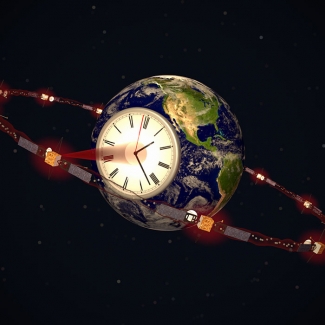Imagine a network of multiple clocks orbiting the Earth, not only reporting down to us, but also collaborating quantum mechanically among themselves to operate precisely in sync as a single global superclock, or world clock. The world clock is delivering the most precise timekeeping in all of human history—to every member nation regardless of politics, alliances, or behavior on the ground. Moreover, the world clock itself is virtually immune to sabotage and can peer under the surface of the Earth to uncover its detailed composition or out into space to reveal a better understanding of fundamental physical principles such as quantum mechanics and gravity.
Welcome to quantum timekeeping in the world of tomorrow. The necessary ingredient in the design of a world clock is quantum entanglement. Entanglement is what Albert Einstein called “spooky action at a distance.” In a world clock, the atoms in each orbiting clock would not only be entangled with each other, but also with the atoms in the other clocks. What this means is that when something happens to a single atom in this global timekeeping system, all the other atoms in all the clocks would respond. The result would be global timekeeping with unprecedented accuracy and precision limited only by the laws of quantum mechanics themselves.
What’s more, by combining the intricately structured clock network with basic techniques of quantum communication, the world clock would be secure from both internal and external threats. Security measures would include preventing nonmember states from eavesdropping on the clock signals and a carefully honed quantum-based strategy for detecting sabotage of individual clocks by member nations. Sabotage would immediately result in the rogue nation being disconnected from the world clock. This would be a serious penalty since the world clock’s primary function would be to control the maintenance and synchronization of national time standards in real time. The national time standards, in turn, are necessary for the control of electric grids, global commerce and stock markets, ground- and space-based observatories, and other activities of modern life.
In addition to helping to smoothly run the world’s advanced technological systems, the world clock will also spur advances in earth science research, more precise navigation of space probes, and a better understanding of the fundamental laws of nature, including the theory of relativity and the connection between quantum physics and gravity.
The amazing proposal for a quantum network of sky clocks comes compliments of graduate student Mike Bishof, Fellow Jun Ye, and their colleagues Péter Kómár, E. M. Kessler, and M. D. Lukin of Harvard University, L. Jiang of Yale University, and A. S. Sørensen of the Niels Bohr Institute (Copenhagen). The Nature Physics article describing the quantum network of clocks appeared online on June 15, 2014. – Julie Phillips




